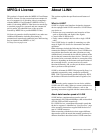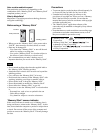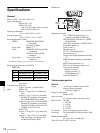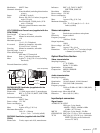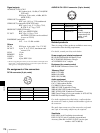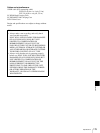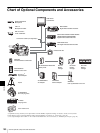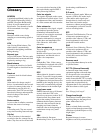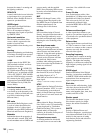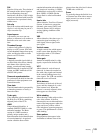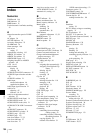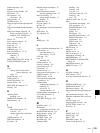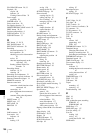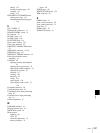
183
Glossary
Appendix
S/N
Signal-to-Noise ratio. The relation of
the strength of the desired signal to
the accompanying electronic
interference, the noise. If S/N is high,
sounds are reproduced with less noise
and pictures are reproduced clearly
without snow.
Sub clip
One of the sections which make up a
clip list. A sub clip may be part of a
clip or an entire clip.
Superimpose
A procedure you use to put one
picture (or character) over another so
that both can be seen at the same
time.
Thumbnail image
A reduced still picture of video for
display on a GUI screen. XDCAM
creates thumbnail images from proxy
video, and displays them as index
pictures on GUI screens.
Timecode
A digitally encoded signal which is
recorded with video data to identify
each frame of the video by hour,
minute, second and frame number.
SMPTE timecode is applied to NTSC
system, and EBU timecode to PAL
and SECAM systems.
Timecode synchronization
To synchronize the built-in timecode
generator of video equipment to an
external timecode.
Time data
Time information that is generated by
a timecode generator or read by a
timecode reader.
Turbo gain
Video amplifier gain increased from
30 dB by 6 to 18 dB by combining
adjacent pixels of the CCD.
UMID
Unique Material Identifier. A
standard (SMPTE 330M) for video
and audio metadata. The Basic
section of a UMID contains a
globally unique number and a
material number for the identification
of recorded material. An optional
section called the Source Pack
contains information such as the time
and location of recording. A UMID
with the Basic section only is called a
Basic UMID. A UMID with the
Source Pack is called an Extended
UMID.
User’s bits
Abbreviation for Total Level Control
System. A function to operate the
automatic gain control (AGC) and
electronic shutter (AE) to adapt to
varying lighting conditions while
shooting.
VBS
Abbreviation for video-burst-sync. A
composite signal consisting of a
video signal, a burst signal, and a
sync signal.
Vertical smear
A bright vertical line which appears
on the screen when shooting a very
bright object with a CCD camera.
Also called smear.
Video gain
Amount of amplification for video
signals, expressed in decibels (dB).
VITC
Abbreviation for vertical interval
timecode. A timecode recorded on
disc with video signals and inserted
in the vertical blanking interval of
video signals. The VTR can read this
timecode even in still mode.
White balance
The balance of the levels of the red,
green, and blue channels of a color
video camera level. When this
balance is correctly adjusted, white
tones appear as a true white.
White shading
When shooting a white subject with a
color video camera, if the lens
characteristics are such that while the
center of the image appears white, the
upper and lower portions suffer a
color imbalance, appearing magenta
or green. This phenomenon is called
white shading.
Zebra pattern
Striped patterns that appear in the
viewfinder to indicate areas of the
picture where the video level is about
70 IRE units or 490 mV.
Zoom
To gradually change the field of view
of a camera lens from wide to narrow
angle (zoom in) or narrow to wide
angle (zoom out).



